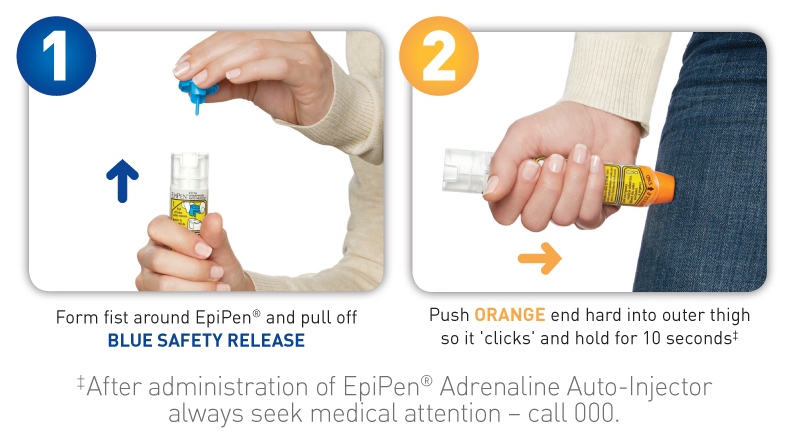Adrenaline auto-injectors

- The most effective first aid treatment for anaphylaxis is a single dose of adrenaline given using an auto-injector (EpiPen®).
- It is injected into the outer mid-thigh muscle and can be administered through a single layer of clothing.
- Adrenaline auto-injectors are designed for use by non-medical people so that anyone can use them in an emergency.
The Therapeutic Goods Administration (TGA) has warned that some batches of EpiPen adrenaline injectors sold to treat allergies and anaphylaxis have been recalled. Read more.
Adrenaline auto-injectors have a shelf life of approximately is 12 to 18 months.
They are also temperature sensitive so should be stored at 15 to 25 °C. Do not refrigerate or leave in heat.
Only the EpiPen® is currently available in Australia.
How to treat anaphylaxis using an adrenaline autoinjector
- Lay the person flat and do not allow them to stand or walk.
- If breathing is difficult, allow the person to sit. If they are unconscious or vomiting, place them on their side in the recovery position.
- Without delay, administer an adrenaline auto injector (EpiPen®) into the patient’s outer mid-thigh.

- If in doubt, give adrenaline auto-injector.
- Call an ambulance – dial 000.
- If there is no response after five minutes and another adrenaline auto injector is available, a further dose may be given.
- If after giving adrenaline, there are no signs of life, commence CPR.
- If you are unsure whether the person is experiencing asthma or anaphylaxis, give adrenaline, then give asthma medication.
- Medical observation for at least four hours after the last dose of adrenaline is recommended after anaphylaxis. If a person is treated with an adrenaline auto-injector, an ambulance must be called immediately to take the person to a hospital.
It is important to practise regularly with an adrenaline auto-injector trainer device
People with anaphylaxis and their carers are encouraged to regularly practise how to use the prescribed adrenaline auto-injector using an adrenaline-auto injector trainer device. The trainer device:
- does not contain adrenaline
- does not have a needle
- simulates the injecting action and ‘click’ sound
- can be repeatedly reset.
A complementary trainer device is provided to you when you join EpiClub (external site)
Adrenaline auto injector trainer devices are also available from Allergy & Anaphylaxis Australia’s (external site).
Adrenaline auto-injectors through the Pharmaceutical Benefits Scheme (PBS)
Adrenaline auto-injectors are prescribed to patients assessed to be at risk of anaphylaxis. A personal ASCIA Action Plan for Anaphylaxis (external site) should be completed by the person’s medical doctor at time of prescribing an adrenaline auto-injector.
Adrenaline auto-injectors are available on a Pharmaceutical Benefits Scheme (PBS) (external site) authority prescription. The authority prescription is provided by, or in consultation with, a specialist, with a maximum of 2 adrenaline auto-injectors per patient at any one time. No repeats can be issued. Renewal is required prior to the device’s expiry.
Continuing PBS authority prescriptions for adrenaline auto-injectors can be provided by your GP. If required, additional devices can be purchased at full price over the counter from a pharmacy without a prescription.
The purchase of additional devices over the counter are not subsidised by the Pharmaceutical Benefits Scheme and supply is at the discretion of the pharmacist who is legally obliged to determine whether the medication is appropriate for the patients specific situation.
A prescription will be provided upon discharge from a hospital or emergency department following treatment for anaphylaxis with adrenaline.
Disposing of adrenaline auto injectors
Used adrenaline auto-injectors that have been administered to treat anaphylaxis can be handed over to the ambulance officer when they arrive for the patient. It is also important to report to the ambulance officer the time at which each adrenaline auto injectors was administered.
Adrenaline auto-injectors that cannot be used (for example, if they have expired, have been accidentally fired or the liquid is discoloured or contains granules) should be disposed of appropriately.
Community pharmacies participate in a return of unwanted medicines service, and can accept medicines for disposal. Your local public hospital also has biohazard bins (yellow or purple), and can dispose of adrenaline auto injectors for you.
Where to get help
- If you have severe symptoms, always dial triple zero (000) to call an ambulance in a medical emergency
- See your doctor
- Visit healthdirect (external site) or call 1800 022 222
More information
Visit the Australasian Society of Clinical Immunology and Allergy (ASCIA) to view a range of information about anaphylaxis, including:
Acknowledgements
Perth Children’s Hospital (PCH)
This publication is provided for education and information purposes only. It is not a substitute for professional medical care. Information about a therapy, service, product or treatment does not imply endorsement and is not intended to replace advice from your healthcare professional. Readers should note that over time currency and completeness of the information may change. All users should seek advice from a qualified healthcare professional for a diagnosis and answers to their medical questions.